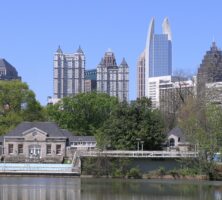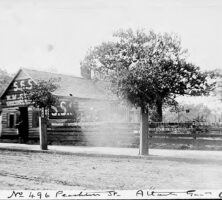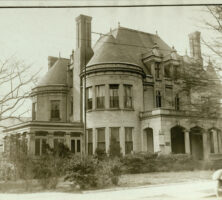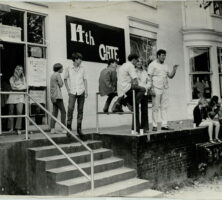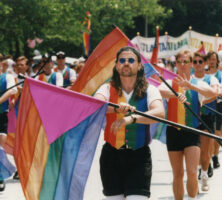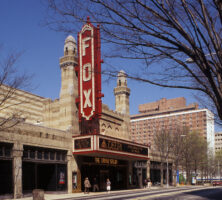Midtown is the second-largest business district in Atlanta and features the largest concentration of arts facilities and organizations in the South. It is bound by Peachtree Station on the north, Ansley Park, Piedmont Park, and Monroe Drive on the east, the Downtown Connector on the west, and North Avenue on the south.
Tight Squeeze
During the 1850s what is now Midtown was a vast stretch of forest and field outside Atlanta’s corporate limits. The section of Peachtree Street that forms the backbone of Midtown today was a narrow country road that served as the main connection between Atlanta and Buckhead. North of Eighth Street and south of Twelfth Street, Peachtree followed a westward bend in order to avoid a deep gulch.
In the years after the Civil War, it was common for persons carrying cash and goods to find themselves waylaid by highwaymen, who attacked travelers as they slowed to ease around the ravine. The shantytown settlement that developed around the bend in the old Peachtree Road was known locally as the “Tight Squeeze,” and it provided the setting for sensationalist tales of family feuds, highway robbery, and murder in the local gossip pages.
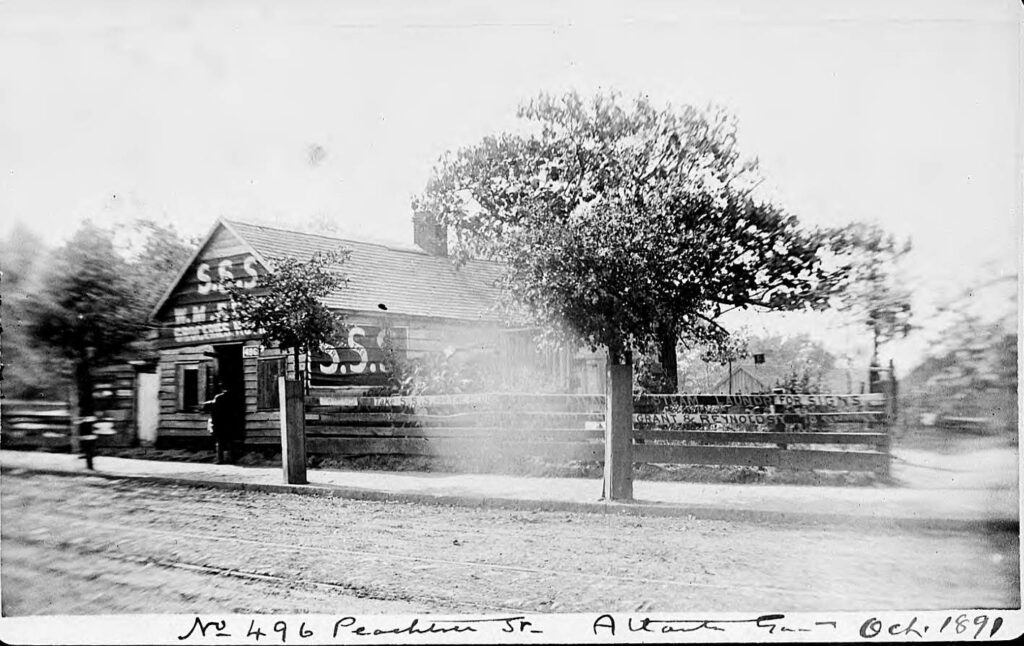
Courtesy of Special Collections & Archives, Georgia State University Library.
Development
Following the 1887 Piedmont Exposition, residential development along Peachtree Street between Eighth and Fourteenth Streets altered Peachtree’s “country road atmosphere,” as prominent merchants, bankers, lawyers, and architects built lavish homes in what had once been Tight Squeeze village. South of Eighth Street, Richard Peters, who purchased the pine forest west of Argonne Avenue in 1849 as a resource for his flour mill, separated his holdings into large lots and sold them at high prices, attracting the city’s elites to the area.
The feverish building activity only increased after the Cotton States and International Exposition of 1895, which saw the extension of streetcar tracks on Piedmont Avenue to Piedmont Park’s main entrance at present-day Fourteenth Street. As the city’s economy continued to boom throughout the first quarter of the twentieth century, the fashionable suburb along Peachtree was eclipsed by larger, garden suburbs such as Ansley Park and Druid Hills.

Courtesy of Special Collections & Archives, Georgia State University Library.
As affluent Atlantans moved further and further afield, the intersection at Peachtree and Tenth Street welcomed multi-family development and an influx of new retail outlets. Elegant apartment buildings were constructed alongside the neighborhood’s streetcar lines, and the once stately homes on Peachtree Street were subdivided into boarding houses or razed altogether. The commercial activity at Tenth Street continued to expand in the years ahead, with locals referring to the district along Peachtree from Eighth to Fourteenth Street as the “Peachtree-10th Street Area.”
Midtown Counterculture
In the years after World War II, Peachtree and Tenth welcomed large numbers of itinerants, students, and singles who were attracted by the area’s inexpensive rent and central location. Younger residents, many of them students from the nearby Atlanta College of Art, crowded into the neighborhood’s old homes, and the community adopted an increasingly bohemian cast. By the late 1960s, Midtown had become the epicenter for Atlanta’s countercultural movement.
Midtown’s reputation for social tolerance only increased in the years ahead, and by the early 1970s, the neighborhood had also become a haven for a burgeoning gay community. Continued economic expansion and liberal politics enhanced Atlanta’s appeal to gays and lesbians, who migrated from small southern towns and settled in in-town neighborhoods like Midtown, Little Five Points, Virginia-Highland, Ponce de Leon-Highland, Morningside, Ansley Park, Buckhead, and Grant Park. A chapter of the Gay Liberation Front opened in 1971 and organized the city’s first gay pride parade from 7th Street to Piedmont Park. By the early 1970s, Atlanta was home to the South’s largest and most prominent gay community.
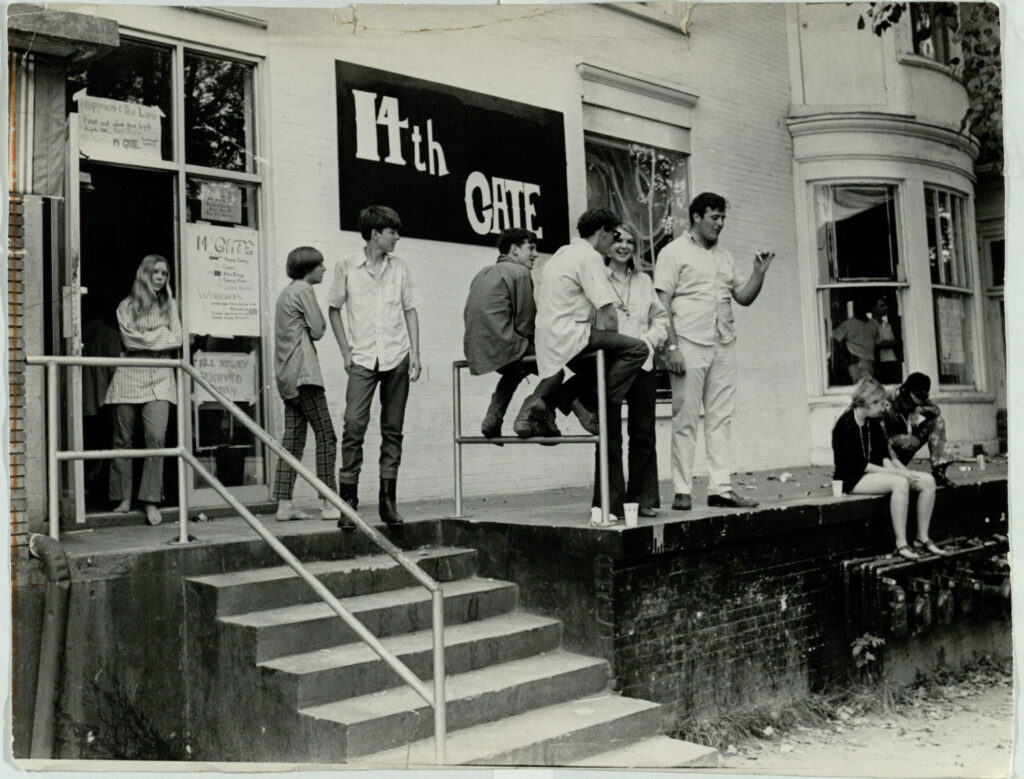
Courtesy of Special Collections & Archives, Georgia State University Library.
Conditions in the neighborhood changed in the 1970s when increased drug traffic led to police crackdowns on the community. Biker gangs were frequently blamed as harbingers of the neighborhood’s decline, though the Midtown Alliance, a neighborhood advocacy organization, contended that the bikers acted as unofficial police in the area and were rarely responsible for disturbances. Resentment against hippies generated violent encounters between neighborhood locals, old-timers, and out-of-towners, and news reports focused increasing attention on the area’s criminal activity.
Midtown Resurgence
Despite the urban malaise, Midtown was on the cusp of significant change. Even as conflicts with officials became routine, young professionals began moving to the neighborhood in ever greater numbers, setting in motion a process of gentrification that continues still. In 1969 neighborhood property owners established the Uptowne Neighborhood Association to promote neighborhood improvement through the renovation of old homes, new construction, and master planning. The association changed its name to Midtown Neighborhood Association in 1972, after a Buckhead mall claimed the “uptown” mantle in a series of advertisements. Six years later, leaders of Midtown’s gay community established the Atlanta Business and Professional Guild to promote financial lending in the neighborhood.
Midtown beckoned large-scale developers in the years that followed as the expansion of the Downtown Connector and MARTA improved access to the area, and a growing arts scene renewed the neighborhood’s vibrancy. Mayor Andrew Young marked the beginning of a development boom in 1984 when he announced that IBM would build a 50-story tower on the corner of Fourteenth and West Peachtree Streets. In 1997 Midtown Alliance released Blueprint Midtown, a master plan that helped fuel the neighborhood’s economic resurgence over the next two decades.

Courtesy of Atlanta Journal-Constitution.
Today’s Midtown is a center of commerce and culture. Global headquarters and regional corporations have made Midtown their home base alongside arts venues like the historic Fox Theatre and High Museum of Art. As of 2014, more than 14,000 people live in the neighborhood, and millions more visit each year.










